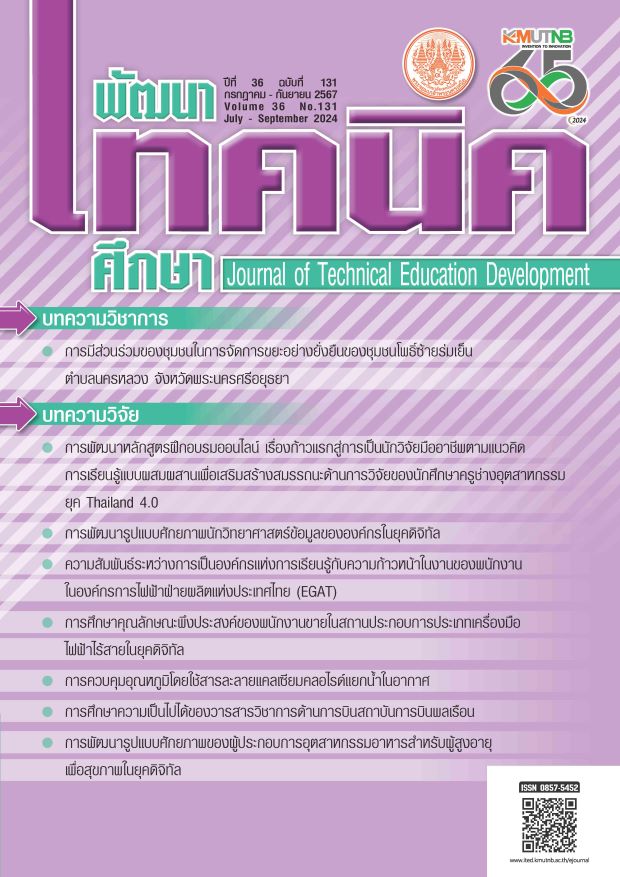The Potential Development Model for Data Scientist in Digital Era Organization
Main Article Content
Abstract
The Purposes of this research were: 1) to study the composition of data scientist potential among in digital era organization and 2) to create a model for developing data scientist potential in digital era organization. This study used a qualitative and quantitative mixed research method; which are 11 experts and 255 respondents. The qualitative study tools used in-depth interview. The tools used in the quantitative study are questionnaires including the executive in data science, data scientist and data science professional. Qualitative data analysis uses content analysis and quantitative data analysis using frequency, percentage, mean, standard deviation. and element analysis (Factor Analysis) with a packaged program.
The results showed that The Potential Development Model for Data Scientist in Digital Era Organization consisted 9 components which are 3 aspects, namely Knowledge aspect consisted 3 components are Data Science Foundation Knowledge, Business Domain Knowledge and Job Responsibility Knowledge; Skills aspect consisted 3 components are Working with Other Skills, Data Analytic and Processing Skills and Presentation Skills; and Attribute aspect consisted 3 components are Professional Attribute, Continuous Develop Mindset and Emotional Maturity.
Article Details

This work is licensed under a Creative Commons Attribution-NonCommercial-NoDerivatives 4.0 International License.
References
We are social. (2022). [online]. DIGITAL2022: ANOTHER YEAR OF BUMPER GROWTH. [cited May 15, 2022]. Available from: https://wearesocial.com/uk/blog/2022/01/digital-2022-another-year-of-bumper-growth-2/
สำนักงานพัฒนาธุรกรรมทางอิเล็กทรอนิกส์. (2563). รายงานผลการสำรวจพฤติกรรมผู้ใช้อินเตอร์เน็ตในประเทศไทย ปี 2563. สำนักยุทธศาสตร์ สำนักงานพัฒนาธุรกรรมทางอิเล็กทรอนิกส์ กระทรวงดิจิทัลเพื่อเศรษฐกิจและสังคม.
Coughlin, Tom. (2018). [online]. 175 Zettabytes By 2025. [cited May 1, 2022]. Available from:https://www.forbes.com/sites/tomcoughlin/2018/11/27/175-zettabytes-by-2025/?sh =46b710b75459
นันทะ บุตรน้อย, สุธีรา ทิพย์วิวัฒน์พจนา, ชมัยพร กาญจนพันธุ์ และ พิทูร กาญจนพันธุ์. (2563). วิทยาศาสตร์ข้อมูลเพื่อการขับเคลื่อนนโยบายสาธารณะ. Local Administration Journal 13(2) ฉบับที่ 13 (2), 204 – 220
Business Over Boardway. (2018). [online]. [cited 28 December 2020]. Available from: http://businessoverbroadway.com/2018/03/18/top-10-challenges-to-practicing-data-science-at-work/
เศรษฐพงค์ มะลิสุวรรณ. (2560). [บทความออนไลน์]. Manager Online: รู้จัก ‘Data scientist’ อาชีพที่เซ็กซี่ที่สุดในศตวรรษที่ 21. [สืบค้นเมื่อวันที่ 1 พฤษภาคม 2565]. จาก https://mgronline.com/cyberbiz/detail/9600000100224
WP. (2018). [ออนไลน์]. ทำความรู้จัก “Data Scientist” อาชีพมาแรงแห่งยุคตลาดงานทั่วโลกต้องการ และค่าจ้างสูงลิ่ว. [สืบค้นเมื่อวันที่ 21 กรกฎาคม 2564] จาก https://www.brandbuffet.in.th/2018/01/data-scientist-job-in-high-demand/
เวปไซด์ขบคิดดอทคอม. [บทความออนไลน์]. 'Data Scientist' นักวิทย์แนวใหม่ รายได้สูง ตลาดต้องการ อาชีพมาแรงแห่งยุคดิจิทัล!!. [สืบค้นเมื่อวันที่ 15 มกราคม 2564]. จาก: https://www.kobkid.com/?s=Data+scientist
ชูศรี วงศ์รัตนะ. (2550). เทคนิคการใช้สถิติเพื่อการวิจัย. พิมพ์ครั้งที่2. นนทบุรี: ไทยเนรมิตกิจอินเตอร์ โปรเกรสซิฟ
ละออ บุญเกษม. (2564). Data Science: วิทยาศาสตร์ข้อมูล. กรุงเทพฯ: เปเปอรี่ พริ้น
ประภาพร กุลลิ้มรัตน์ชัย. (2561). การเข้าสู่ยุคดิจิทัล. วารสารวิชาการ มหาวิทยาลัยอีสเทิรน์เอเชีย ฉบับวิทยาศาสตร์และเทคโนโลยี. ปีที่ 12 ฉบับที่ 12 120 – 129
อสมา กุลวานิชไชยนันท์. (ม.ป.ป.). Big Data Series II: คิดแบบนักวิทยาศาสตร์ข้อมูล. พิมพ์ครั้งที่ 2. นนทบุรี: สำนักพิมพ์มหาวิทยาลัยสุโขทัยธรรมาธิราช
Fujitsu. (2012). Big Data: The definitive guide to the revolution in business analytics. Fujitsu Services Ltd.


